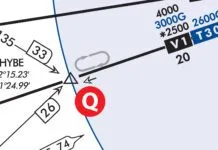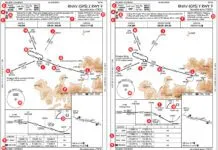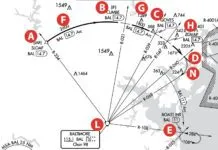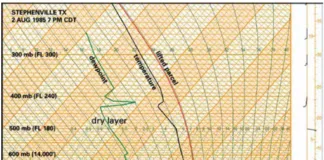This past year we’ve delved rather deeply into many of the details and vagaries of approaches you can fly with your satellite-based navigator. To do so, we’ve used many industry-standard terms and their common acronyms. Since a lot of these are unfamiliar to many pilots, we’ve gotten criticized for our journey through the “acronym jungle,” as one reader put it.

But many of these new acronyms are becoming part of our lexicon and can’t be dismissed. We’ve realized it’s our duty to present this—far from complete—list of acronyms of interest to instrument pilots, including a highly simplified definition. We’ve underlined the ones that we feel should be well understood by all active instrument pilots.
Enjoy your journey through the acronym jungle of TAA instrument flight.
ADS-B Automatic Dependent Surveillance-Broadcast: An ATC technology where aircraft broadcast their GPS position to aircraft and to ground stations that rebroadcast it to more aircraft.
APV Approach with Vertical Guidance: Procedures that achieve ILS-like precision but aren’t ILSes.
ASDA Accelerate-Stop Distance Available: Essentially remaining available runway plus any stopway.
Baro-VNAV Vertical nav for RNAV approaches using pressure altimetry.
CANPA Constant Angle Non-Precision Approach: A constant rate descent to minimums. See CDFA.
CDFA Continuous Descent Final Approach: The opposite of the “dive-n-drive” method of flying a nonprecision approach, CDFAs use a calculated descent rate from FAF to the runway.
CFIT Controlled Flight into Terrain.
CNF Computer Navigation Fix: A fix created to facilitate electronic navigation databases. The name was depicted in parenthesis and the point designated with an X, but now there is little or no depiction difference from regular fixes.
DA Decision Altitude: The point in feet MSL at which you must decide to land or miss on an ILS or APV.
DER Departure End of Runway.
DH Decision Height: The point in feet AGL at which you must decide to land or miss on an ILS or APV.
DME Distance Measuring Equipment: A technology that times a radio pulse and its return to measure distance from an aircraft to a ground station.
EFIS Electronic Flight Information System: An electronic display of primary and/or auxiliary flight information.
FAF Final Approach Fix: A fix that defines the beginning of the final segment of an instrument approach.
FIKI Flight Into Known Icing: A certification of aircraft equipment that prevents and/or removes ice accumulation to permit flight in some icing conditions.
FIS–B Flight Information System-Broadcast: Part of ADS-B, FIS-B transmits weather data.
GBAS Ground Based Augmentation System: A technique to improve GPS accuracy by transmitting an error correction from ground stations. Formerly know as LAAS.
GLS Was GPS Landing System, now GBAS Landing System: An APV using GPS and local ground stations that transmit error correction signals.
GNSS Global Navigation Satellite System: Satellite navigation. GPS is but one GNSS. Others include GLONASS, Galileo or Beidou.
GPA Glidepath Angle.
HAA Height Above Airport.
HAT Height Above Touchdown.
HATh Height Above Threshold.
HILPT Hold In Lieu of Procedure Turn: A course reversal on an approach accomplished via a hold instead of a procedure turn.
IAF Initial Approach Fix: Where enroute ends and a full approach begins.
IAP Instrument Approach Procedure.
ICAO International Civil Aviation Organization: The international standards body. Most member countries adopt ICAO standards as regulations.
ILS Instrument Landing System: A ground-based system and approach providing lateral guidance through a localizer signal and vertical guidance through a glideslope signal.
LAAS Local Area Augmentation System: The original name for ground-based position error correction of GPS signals. Now called GBAS.
LAHSO Land And Hold Short Operations: When a landing aircraft must hold short of an intersecting runway.
LDA Localizer-type Directional Aid: An approach type using a localizer more than three degrees offset from the runway. May incorporate a glideslope.
LNAV Lateral Navigation: Two-dimensional navigation as in following a course. Does not include altitude.
LOC Localizer: A ground-based radio signal providing precise lateral navigation. An approach based on a runway-aligned localizer. Also, the lateral guidance portion of an ILS.
LPV Localizer Precision with Vertical: An RNAV approach with vertical guidance, requiring WAAS/SBAS.
MAP Missed Approach Point: The charted point on a nonprecision approach beyond which you must be landing or on the missed approach.
MDA Minimum Descent Altitude: The minimum altitude to which you may descend on a nonprecision approach unless you see the runway environment.
MFD Multi-Function Display: An electronic display depicting a variety of information, such as graphical flight plan, terrain, weather, traffic, radar, etc.
MVA Minimum Vectoring Altitude: The minimum altitude at which a TRACON facility may provide vectors, considering terrain, radar coverage and communications coverage.
NORDO No Radio, or broken radio.
NPA Nonprecision Approach: Generally, any approach that is neither a precision approach (ILS) nor an APV.
OCS Obstacle Clearance Surface: ROC is applied to OEA to get OCS—the surface on an instrument procedure above which there are no obstacles.
ODP Obstacle Departure Procedure: A procedure for departing an airport while maintaining safe obstacle clearance. Usually documented only in print.
OEA Obstacle Evaluation Area: The lateral boundaries of an area that is evaluated for obstacles on an instrument procedure.
OTS Out of Service: Unusable.
PANS-OPS Procedures for Air Navigation Services-Operations: Procedure design standards. ICAO has PANS-OPS; the FAA has TERPS.
PFD Primary Flight Display: An EFIS display of the primary flight instruments—airspeed, attitude, altitude, turn, heading and vertical speed.
PRM Precision Runway Monitor: A supplementary approach type (e.g. ILS/PRM) permitting simultaneous operations to closely spaced parallel runways.
PT Procedure Turn.
RAIM Receiver Autonomous Integrity Monitor: A means for measuring and predicting GPS accuracy to determine suitability for navigation.
RF Radius to a Fix: Like a DME arc provides curved course guidance based off a DME ground station, RF provides curved course guidance between two points using RNAV.
RNAV Area Navigation: Point-to-point navigation by electronic means.
RNP Required Navigation Performance: Per ICAO, this is a statement of navigation system performance accuracy, integrity, continuity and availability.
ROC Required Obstacle Clearance: Each procedure type requires a specified minimum obstacle clearance, or ROC. This often varies with the distance from the center of the charted course.
RVSM Reduced Vertical Separation Minima: Previously, only odd flight levels were used above FL290. With RVSM’s increased precision requirements, odd and even flight levels are available.
SBAS Satellite Based Augmentation System: Dedicated satellites provide error correction signals for satellite navigation. WAAS is an SBAS.
SDF Simplified Directional Facility: A localizer-like signal and approach, but with wider beam and reduced precision.
SID Simplified Instrument Departure: A charted departure procedure from a terminal that meets obstacle clearance and other ATC requirements.
SOIA Simultaneous Offset Instrument Approach: A PRM where the runways are so close together that the aircraft must be offset or staggered, not side-by-side.
STAR Standard Arrival Route: A charted arrival procedure into a terminal designed primarily to simplify ATC operations.
TAA Technically Advanced Aircraft: Generally, aircraft equipped with EFIS and/or sophisticated multi-sensor navigators with databases.
TCH Threshold Crossing Height: The height in feet above the runway of the glidepath at the runway threshold.
TDZ Touchdown Zone: The first 3000 feet of a runway.
TDZE Touchdown Zone Elevation: Highest elevation in feet MSL of the runway’s touchdown zone.
TERPS Terminal Procedures: Generally used to describe the design criteria and requirements for FAA instrument procedures.
TIS-B Traffic Information System-Broadcast: Part of ADS-B, TIS-B broadcasts traffic information to participating aircraft.
TODA Takeoff Distance Available: TORA plus any available clearway.
TORA Takeoff Runway Available: The runway length defined by the airport authority as available for takeoff.
TRACON Terminal Radar Control.
UATUniversal Asynchronous Transceiver: Although ADS-B capabilities can be included in other systems, a UAT is a dedicated separate device meeting ADS-B requirements.
VCOA Visual Climb Over Airport: A VMC departure option for IFR operations.
VDA Vertical Descent Angle: An angle calculated from the FAF (or later if necessary to meet step-down altitudes) to a point above the runway threshold.
VDP Visual Descent Point: Where a normal descent angle from the runway intersects the MDA.
VGSI Visual Glideslope Indicator: Lights providing glidepath guidance.
VNAV Vertical Navigation: Altitude guidance. Typically used in conjunction with enroute crossing restrictions and approaches.
WAAS Wide-Area Augmentation System: A system using dedicated satellites to provide error correction to GPS position fixes. WAAS is an SBAS.





